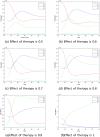Modeling the impact of antiretroviral therapy on HIV and related kidney diseases in Tanzania
- PMID: 40097717
- PMCID: PMC11914296
- DOI: 10.1038/s41598-025-94114-x
Modeling the impact of antiretroviral therapy on HIV and related kidney diseases in Tanzania
Abstract
This work presents a mathematical model for the dynamics of HIV-related kidney diseases. The study examines two cases, considering the effects of the absence of treatment and the effects of Highly Active Antiretroviral Therapy (HAART) on different infection groups. Studying these cases is important because many developing countries implement HAART late, and not all HIV-infected individuals receive this therapy. Kidney diseases in HIV individuals are modeled as arising from both HIV infection itself and the use of nephrotoxic drugs. In the analysis of the mathematical model, it is shown that the state variables of the model are non-negative and bounded. Furthermore, we derived a formula for control reproduction number [Formula: see text] which was used to compare the cases considered. The sensitivity analysis of the model reveals that the effect of HAART in reducing the progression from HIV to HIV-related kidney diseases is more significant compared to other effects of HAART on disease dynamics, which is also confirmed through numerical simulations. The Markov Chain Monte Carlo (MCMC) method was used to estimate parameters and evaluate the model using real data of the HIV population from Tanzania from 1990 to 2022. Numerical simulations demonstrated that while HAART reduces HIV progression to the AIDS stage, the population of individuals with HIV-related kidney diseases is increasing and is projected to continue increasing. Additionally, the results show that improving the effectiveness of HAART by 90% in preventing the progression from HIV to HIV-related kidney diseases can significantly decrease the prevalence of HIV-related kidney diseases. This study addresses a gap in understanding how population-level HAART availability influences the dynamics of HIV-related kidney disease, particularly in settings with delayed or inconsistent treatment access. By analyzing disease progression under these conditions, our findings provide insights that can inform public health strategies for improving HIV care in resource-limited settings and other contexts where access disparities persist. In addition, the work investigated scenarios related to data quality in which the model parameters can be well identified, which can serve as a guide for obtaining informative real data.
Keywords: HIV-related kidney diseases; Markov chain Monte Carlo; Mathematical model; Reproduction number; Sensitivity analysis.
© 2025. The Author(s).
Conflict of interest statement
Declarations. Competing interests: No competing interests exist in the submission of the manuscript.
Figures



















Similar articles
-
Highly active antiretroviral therapy and the epidemic of HIV+ end-stage renal disease.J Am Soc Nephrol. 2005 Aug;16(8):2412-20. doi: 10.1681/ASN.2005040340. Epub 2005 Jun 29. J Am Soc Nephrol. 2005. PMID: 15987747
-
Study of the impact of HIV genotypic drug resistance testing on therapy efficacy.Verh K Acad Geneeskd Belg. 2001;63(5):447-73. Verh K Acad Geneeskd Belg. 2001. PMID: 11813503 Review.
-
Early Treatment in HIV Patients: A Cost-Utility Analysis from the Italian Perspective.Clin Drug Investig. 2016 May;36(5):377-87. doi: 10.1007/s40261-016-0382-2. Clin Drug Investig. 2016. PMID: 26940802
-
Cost effectiveness analysis of routine use of genotypic antiretroviral resistance testing after failure of antiretroviral treatment for HIV.Antivir Ther. 2004 Feb;9(1):27-36. Antivir Ther. 2004. PMID: 15040534
-
HIV-associated neurological disorders: a guide to pharmacotherapy.CNS Drugs. 2012 Feb 1;26(2):123-34. doi: 10.2165/11597770-000000000-00000. CNS Drugs. 2012. PMID: 22201342 Review.
References
-
- Huo, H.-F. & Chen, R. Stability of an HIV/AIDS treatment model with different stages. Discret. Dyn. Nat. Soc.2015, 630503 (2015).
-
- UNAIDS, D. Report. Retrieved February (2021).
MeSH terms
Substances
Grants and funding
LinkOut - more resources
Full Text Sources
Medical
Miscellaneous

